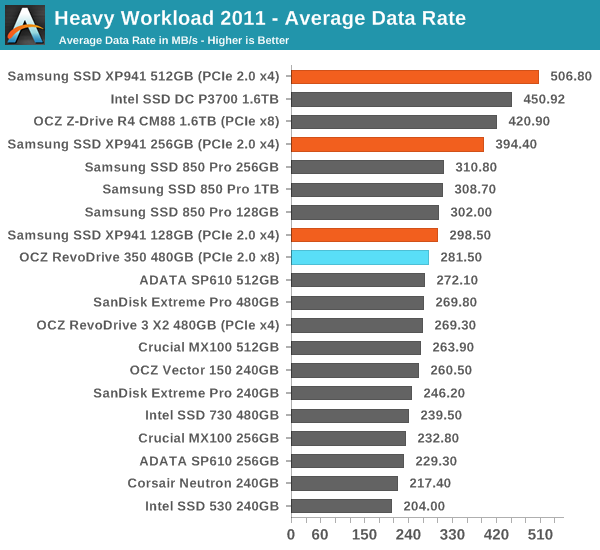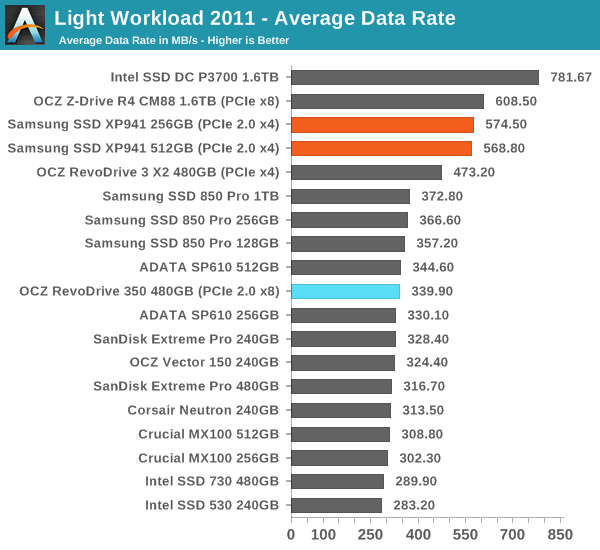PCIe SSD Faceoff: Samsung XP941 (128GB & 256GB) and OCZ RevoDrive 350 (480GB) Tested
by Kristian Vättö on September 5, 2014 3:00 PM ESTAnandTech Storage Bench 2011
Back in 2011 (which seems like so long ago now!), we introduced our AnandTech Storage Bench, a suite of benchmarks that took traces of real OS/application usage and played them back in a repeatable manner. The MOASB, officially called AnandTech Storage Bench 2011 – Heavy Workload, mainly focuses on peak IO performance and basic garbage collection routines. There is a lot of downloading and application installing that happens during the course of this test. Our thinking was that it's during application installs, file copies, downloading and multitasking with all of this that you can really notice performance differences between drives. The full description of the Heavy test can be found here, while the Light workload details are here.

In our 2011 suite the 256GB XP941 is still strong, but the 128GB model and RevoDrive 350 are no better than a SATA drive. The 128GB XP941 simply lacks parallelism because of its small capacity, whereas the RevoDrive is better suited for very intensive workloads (like the 2013 suite). The average service times (although not graphed here) are still better than what SATA drives offer, but the truth is that a RAID array will only help if there are more IO to process i.e. in high queue depth and large transfer situations.











47 Comments
View All Comments
Intervenator - Friday, September 5, 2014 - link
Need MOAR insight into the PCIe SSD market! Wheres it going? Any noticeable performance increased to the end user? Who are the players in the market? Non performance advantages?If AnandTech has already written an article regarding any of this, could someone please point me towards it?
Intervenator - Friday, September 5, 2014 - link
Oh, and great review.Kristian Vättö - Friday, September 5, 2014 - link
We haven't done an article that collects all bits of info into one, but you may find the following articles interesting:http://www.anandtech.com/show/8006/samsung-ssd-xp9...
http://www.anandtech.com/show/7843/testing-sata-ex...
http://www.anandtech.com/show/7520/lsi-announces-s...
http://www.anandtech.com/show/8147/the-intel-ssd-d...
http://www.anandtech.com/show/8104/intel-ssd-dc-p3...
frenchy_2001 - Friday, September 5, 2014 - link
>Where is it going?M.2 form factor using PCIe gen3 x4 for portable and consumer, PCIe cards, up to Gen3 x8 for Datacenter/server. Both running NVMe protocol.
I don't see much future for SATAexpress, as the 2 other competing standards cover all the use cases already (and better too).
> Any noticeable performance increased to the end user?
Not unless you do a LOT of parallel IOs. For consumer, there is a diminutive return past the original boost from switching to SSD (mostly from lower latencies). HDD to SATA SSD gave orders of magnitude improvements. SATA3 -> PCIe is only incremental compared to that. Unless you need this for a server, video processing or other big IO limited task, there will be little difference.
>Who are the players in the market?
Still the same: Intel/Micron/Samsung/Sandisk for professionals/servers using mostly in-house designs (intel P3700 for example).
Marvel and Sandforce have announced PCIe NVMe controllers. No products for those yet.
>Non performance advantages?
M.2 will be more compact. Power draw should be more optimized. NVMe should have lower processor overhead.
Impulses - Friday, September 5, 2014 - link
Thx for that.iwod - Saturday, September 6, 2014 - link
Since speed is a relative thing. The HDD to SSD leap were amazing. But that doesn't mean you cant feel the different between SSD @ SATA 3GBps and SSD@ 6Gbps. And with the recent controller improvement on Random / Seq RW, I can also feel the difference between SATA and NVMe PCIe SSD.But with the increase memory capacity, the time to fetch things SSD will also be lower since they are likely cached. So throughput may become less of a concern after PCIe SSD, and average response time will play a role. Luckily this is already being worked on for server SSD usage. So they will likly filter down once PCIe SSD becomes mainstream.
For the future I would like to see even lower active power consumption. I wonder if they could get it under 2W.
Friendly0Fire - Friday, September 5, 2014 - link
This makes me think that the SM951 with X99 will be one hell of a beast... I want one. Heck, the XP941 would already be amazing.GrigioR - Friday, September 5, 2014 - link
Is it possible to boot from those PCIe drives using a 775 motherboard (p35chipset)? Getting rid of Satall bottleneck would be awesome on my modded Xeon system.Kristian Vättö - Friday, September 5, 2014 - link
The SM951 likely won't be bootable since it is an OEM drive, but there will be retail PCIe SSDs that are bootable even in older systems (the Plextor M6e should be, for instance).GrigioR - Sunday, September 7, 2014 - link
Nice. Too pricey 1$/GB on the 256GB model... Since my motherboard is PCIe 1.0/1.1 it would run at 500MB/s max... That should not be that noticieable. My Samsung 840 120/128GB runs at +- 250-260MB/s (read)... At least if it were a PCIe x4 it would do 1000MB (bus speed). I`ll leave this the way it is for now. Thank you very much for your input. Now i know it is possible.